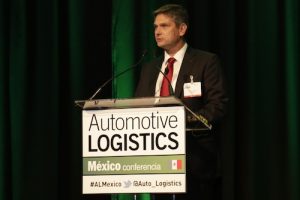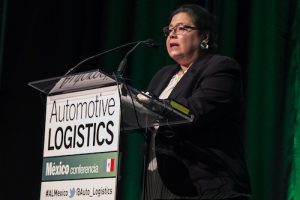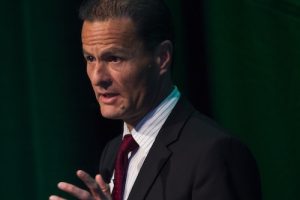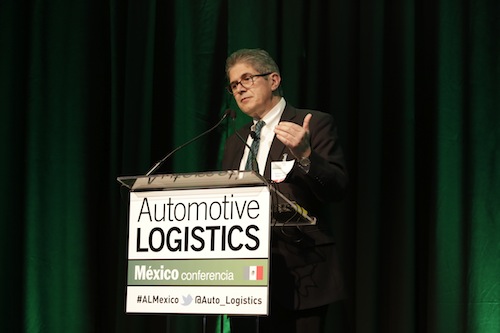Mexico’s automotive industry is inextricably linked with its neighbours to the north but under its new president the US is talking about renegotiating NAFTA and applying border taxes to imports. At this year’s Automotive Logistics Mexico conference, held in Mexico City, industry and government heads looked for positive signs in an uncertain political climate
For a country with its automotive industry very much on the up, Mexico has some big problems to overcome this year. Vehicle production last year reached 3.5m units, of which 2.8m were exported, and the country is now the seventh biggest vehicle-producing nation in the world. However, a sharp rise in fuel prices at the beginning of the year has hit transport costs while an equally severe devaluation of the peso (by 60% since 2014) has increased the cost of equipment, including car carriers, since most of the trucks and trailers in use there are made in the US.
And then there was the what was referred to several times at this year’s Automotive Logistics Mexico conference as ‘the elephant in the room’: President Trump and his threats of an import border tax for parts and vehicles coming out of Mexico as well as his pledge to renegotiate the terms of the North American Free Trade Agreement (Nafta).
Given all that, one could be forgiven for thinking that the only thing that is certain in Mexico’s automotive industry at the moment is uncertainty. That is exactly how the director of international promotion for the State of Guanajuato, Manuel Fernández, saw it in the wake of Ford’s decision to pull its plans for a $1.6 billion production plant in neighbouring state San Luis Potosi.
That decision, which followed sustained threats by Donald Trump of a border tax for imports of cars and parts from Mexico to the US, both before and following his election, came as a blow given that the region has become a Mexican hub for automotive production. Guanajuato has made some sizable commitments to supporting the automotive industry and that commitment has been reciprocated with investment from carmakers and tier suppliers to locate there.
Ford’s withdrawal, which it said was down to slowing demand for the smaller vehicles intended for the plant rather than Trump’s threats, has had repercussions in the supplier community and Fernández admitted that some companies with links to the project had pulled out.
“We got some collateral damage,” said Fernández. “Some companies have [also] decided to postpone and some companies have decided to adjust the scope of the project because today, the only thing [that is] certain is uncertainty.”
Nevertheless, Fernández said it was in the best interests of the US to continue as a partner with Mexico, something that would give greater reassurance to companies worried about major changes affecting their business plans. Although there have been some signs of hesitance over investment in Mexico already due to concerns about the Nafta negotiations, there was reassurance from the record number of delegates who were polled at the conference as to whether they would continue to invest in Mexico over the next year despite the uncertainties – 72% said they would.
And after all, Ford has not totally abandoned its plans in Mexico; it is continuing with its $1.3 billion expansion of a transmission plant in Irapuato, in Guanajuato state.

Audi up and running [sta_anchor id=”1”]Greater confidence in Mexico’s future has been shown by Audi, meanwhile, which is proceeding at full steam at its plant in San José Chiapa, in the state of Puebla. Production is already underway at the $1.1 billion plant, which is making the Q5 SUV for global markets.
Peter Koltai, director of production control and logistics at Audi Mexico, explained that as well as production at the plant having started, full operations were now underway at the logistics centre supporting the plant, which includes a warehouse, packaging pool, trailer yard and truck control centre. According to Koltai, this is ensuring stable delivery of parts to the plant. The facility is also supported by a just-in-sequence (JIS) supplier park.
“We wanted to have as many suppliers as possible beside our factory and have [parts] JIS delivered,” said Koltai. Nine out of the 12 companies there are suppliers. Companies at the park include parts suppliers Faurecia ET, HBPO, ThyssenKrupp Automotive, Truck and Wheel, and TI Automotive. The logistics providers on site are Kuehne + Nagel and syncreon.
Audi has a completely new supplier structure supporting production. The plant gets material from 300 suppliers in Europe, with the major part of the logistics flow taking place in the North America region. There are 200 suppliers based in North America, of which 70 have built new facilities to deliver for Audi.
Koltai was keen to flag up the strength of the relationships it had with suppliers in Mexico. “The better the relationship, the better the solutions they offer,” he said. “I have never seen flexibility from suppliers like this. Even if it is a Sunday and you need a delivery, it will be done.”
There are some areas that still need to be improved. The company is addressing some existing issues with Audi’s quality requirements and a high fluctuation of staff means knowhow often has to be reiterated.
Koltai said there were also problems to overcome in terms of stock levels and labelling of parts. He said 10% of suppliers could not maintain the stock level required for stable production, while 9% delivered it to the wrong quality standard, affecting logistics.
“What is also a problem is the labelling, which can sometimes be wrong,” he noted, specifying that 3% of parts were wrongly labelled. “The part number doesn’t match with the label and that is a logistics nightmare and can stop the line.”
On the plus side, Audi has invested in new packaging for the project and has 100% coverage of the parts from the supplier to the plant through the inclusion of RFID chips on the component packaging.
“We have the RFID infrastructure in the factory throughout, and have dispatch docks covered by the RFID readers,” he said.
While tag reading hasn’t been 100% all of the time, Koltai said the company had still achieved good results.
“There is good transparency and it shows us how long the packaging stayed with the provider and the way it was handled by the different suppliers,” he said. “We see an interesting future for this, but it is complex and we need time to make the most of it.”
 Dr Karl-Friedrich Koch, vice-president of production control and logistics, BMW Mexico
Dr Karl-Friedrich Koch, vice-president of production control and logistics, BMW MexicoRenegotiating Nafta[sta_anchor id=”2”]Carmakers are doing their best to deal with the prevailing uncertainty over Nafta and continued investment like Audi’s is bolstering confidence to some extent.
BMW Mexico’s vice-president of production control, logistics, VPS, Dr Karl-Friedrich Koch, said that its decision to build its plant in San Luis Potosi was going ahead without any problems but admitted that the move was based on the existence of Nafta. There are now questions hanging over what Nafta will look like, given president Trump’s assertion that he wants to renegotiate its terms.
Nevertheless, Koch said BMW would continue to invest in the plant and that none of its suppliers were retreating. “We are continuing; so they are,” he said simply. That said, the carmaker has been working on some ‘what if…’ scenarios should Nafta be renegotiated significantly.
Volkswagen is also continuing as normal and investing in its outbound services. Alfonso Guttierez, transport planning manager, at VW Mexico, said the carmaker had just concluded 16 different tenders for outbound road services and that those new players were making their own investments in trucks to support its requirements.
VW is also going ahead with its investment in a three-shift rail loading/unloading project at Veracruz that will help solve the bottleneck in vehicle processing at the port by including a night service.
“Nobody has done so because of the light conditions, because you cannot inspect the vehicles on the handover,” said Guttierez. “We are investing with our rail company in a complete infrastructure with illumination so we can operate at night.”
Koch’s point that continued investment was based on the existing Nafta agreement and that any renegotiation was a cause for concern was shared by a number of delegates. Based on the agreement, Mexico has received significant investment in assembly plants, supplier facilities, equipment and services. In the central state of Guanajuato alone, more than $10 billion has been committed for the period from 2012 to 2018, according to Manuel Fernandez
 Oscar Albin, executive president of the National Industry of Automotive Parts
Oscar Albin, executive president of the National Industry of Automotive PartsOscar Albin, executive president of the National Industry of Automotive Parts (NAIP), pointed out that unravelling the Nafta agreement could start a trade war that would damage the US and increase unemployment.
However, Manuel Fernández acknowledged that while there was uncertainty over Nafta, most of the partners working with the state of Guanajuato were continuing their expansion projects.
Albert Zapanta, president and CEO at the US-Mexico Chamber of Commerce, was in no doubt about the continuation of the Nafta agreement, however. He said that Nafta was never a static agreement and a lot had already changed over the 23 years since it was set up, adding that during those original negotiations the US-Mexico Chamber of Commerce had the opportunity to put its position.
“And here we are again,” he said, “we are in the middle of political dialogue. I know Trump and [Mexican president] Peña Nieto. Both have their philosophies but when you hear that we are going to lose Nafta – that is not happening. It is more likely that any discussions will be about what areas can be taken up.”
Border tax tactics[sta_anchor id=”3”]Zapanta was equally confident when it came to the threat of border taxes for automotive companies based in Mexico exporting to the US. As has been reported, Trump has made a number of threats that a border tax of 20% would be applied to parts moving north. He also made several announcements that carmakers building in Mexico with the aim of exporting vehicles to the US could expect a 35% tariff.
Zapanta said categorically that there would not be a 20% border tax and that it was a negotiation tactic typical of Trump.
“I will tell you that in my dealings with president Trump, he loves to negotiate. He throws down the start of the discussion and then gets into the options,” said Zapanta.
He went on to point out that while Trump moved fast on opinion, bureaucracy and government did not move at the same speed. While stating that nothing definitive had yet come out of the discussions because they were at an early stage, Zapanta felt confident enough to reassert: “You are not going to see a 20% border tax.”
Applying a blanket border tax to components or vehicles defies the complexity involved in the cross-border moves typical of the automotive industry. A vehicle, for instance, could cross the border nine times before it is finished. Zapanta asked how one could apply a border tax to that and who would be affected.
His point was backed up by Maria Verónica Orendain de los Santos, general director of heavy industries and high tech at Mexico’s Secretariat of the Economy.
“The inter-commercial relationship with North America for certain automotive products means they are coming in and out of the country up to nine times,” she pointed out. “The underlying transformation [of the product] cannot be measured against the deficit of the balance and you would have to measure a different product. The deficit levelled at Nafta needs to be analysed in greater detail.”
Zapanta said the facts behind any tariffs would only be clear and free of political rhetoric when the final trade negotiations were signed. Moreover, he said that the private sector, including the automotive industry, would be in the middle of those trade negotiations. “As you know government policy and regulation is driven by what we do in the private sector,” said Zapanta.
 Albert Zapanta, president and CEO at the US-Mexico Chamber of Commerce
Albert Zapanta, president and CEO at the US-Mexico Chamber of CommercePart of the machinery[sta_anchor id=”4”]The fact is that the North American supply chain, like its rail network, is tightly integrated and the US would find it very difficult to produce the parts it currently imports from Mexico to support production levels at its assembly plants.
Part of that is simply down to geographic advantage but that contiguity could not be underestimated in terms of its advantages for industry on both sides, according to Orendain de los Santos.
“We have one of the most important borders with our most important neighbour,” she said. “This is a chain of industry and relationships. Mexican suppliers have a great advantage over other markets such as China and Japan because it can take them an additional 15-20 days to supply the US.”
It is also down to the strength of the domestic industry. Mexico is helping to drive manufacturing in North America because of its parts supply, an industry that is in the top 10 globally. There are currently around 1,500 tier supplier plants in Mexico supporting the continued growth in local production but also sending 75% of the automotive parts they make north of the border, estimated to be worth more than $62 billion in 2016. At least 63% of a vehicle made in North America is regionally sourced and a great deal of that local content is produced in Mexico.
“Volume production in the US has increased and much of that growth is down to cooperation with Mexico,” said Oscar Albin at the NAIP. “We are part of the machinery.”
Orendain de los Santos said that while there may be a drive to review Nafta, existing operations in Mexico could not be changed in the short term or moved elsewhere because of the depth of integration between the two countries.
Furthermore, imposing higher taxes on imports north would isolate the US, according to Albin, and lead to a situation similar to that in Brazil, where protectionism forced up the price of consumer products, including vehicles. “US consumers are not looking for that,” he said.
Mexico is hugely dependent on the continued success of US and Canadian vehicle assembly for its own business and the 750,000 people employed there to make automotive parts, added Albin.
“We have to assume that there is a scarcity of labour in the US that want to work on foundries or plants,” he said. More specifically, he indicated that there was not enough labour in the US willing to work for what the average Mexican factory worker earns, which is why the US needs a low-cost country such as Mexico to provide it.
On average, Mexican automotive wages are between one-eighth and one-fifth what is paid to automotive workers in the US, according to figures from the Center for Automotive Research (CAR). US workers making parts are on almost $20 an hour while their Mexican counterparts earn around $2.50.
 Maria Verónica Orendain de los Santos, general director of heavy industries and high tech, Secretariat of the Economy
Maria Verónica Orendain de los Santos, general director of heavy industries and high tech, Secretariat of the EconomyThat said, most engineers that work on parts production in Mexico focus on areas such as electronics or powertrain and the country is lacking skills at the master’s (MSC) level. According to Albin, the industry needs more people with software development skills and English language skills.
Complex logistics[sta_anchor id=”5”]A good example of how integrated Mexico is with the US in terms of cross-border parts movements and what the risk to that integration is now was provided by Mexican tier supplier Bocar Group, which makes aluminium and plastic components for a range of carmakers both sides of the border, including FCA, GM, Ford, Nissan, and VW.
Carlos Lazzeri, logistics group manager at the company, explained that parts shipments from its plants were pretty evenly split between Mexico (51%) and the US (47%), with full truckloads (FTLs) sent from its 11 facilities in Mexico to distribution centres in Manchester, Tennessee and Laredo, Texas. Only 2% of parts are sent further afield, indicating how crucial the relationship between Mexico and the US is to Bocar Group and its customers.
In terms of inbound logistics, the picture is a little more mixed, with 41% of subcomponents sourced from Mexico and delivered directly to its plants, and 28% coming in from the US on less-than-truckload (LTL) deliveries via Laredo and El Paso. Europe supplies 29% of parts inbound in a combination of LTL and full container loads (FCLs).
From a logistics point of view these inbound and outbound parts movements are becoming more complex, as the OEM customer looks for full service solutions, assembly parts, kitting and just-in-time/sequence deliveries. “They want a simple process and all the complexity taken care of by the supplier,” said Lazzeri. At the same time, Bocar is faced with the risks associated with a depreciating peso and the threat of a crisis in terms of supply with the US.
“We have a high pressure to accept a peso policy from customers for what we sell in Mexico [but] we have a lot of components coming from outside in US dollars and that is a big risk to us,” said Lazzeri.
The company is also reserved in the current climate about over-investment in new technology and is instead making the most efficient use of its existing resources. For Lazzeri, fuel price, politics and government are things that are out of Bocar’s control but he said he recognised that the company had to adapt to the changes ahead, and the sooner the better. That meant being focused on the job in hand whatever the outcome, he acknowledged – a sentiment shared by Frank Bateman, director of customer logistics at Ryder.
 Carlos Lazzeri, logistics group manager, Bocar Group
Carlos Lazzeri, logistics group manager, Bocar GroupHome-grown challenges[sta_anchor id=”6”]The big investments already made in Mexico by global carmakers and suppliers mean that, however the Trump administration’s policies turn out, the automotive industry in the country is not going away and neither are some of its problems.
One of the biggest issues for the logistics providers supporting the industry is the perennial problem of bottlenecks at the borders and the ports. The government is investing $100 billion in infrastructure to meet demand but delays on shipments of both parts and finished vehicles are common. Five ports are handling 65% of all international ocean freight and five airports 85% of all international air freight. Double the number of shipments cross the US-Mexico border every day compared to when Nafta was established, but the customs clearance process is outdated and there are limited operating hours, which all leads to congestion, said Bateman.
Toll roads are preferential to the dilapidated and congested network of free roads (which are also where most thefts occur) but they are an added cost at a time when costs are already rising.
Mercedes Figueroa, FCA Mexico’s head of inbound, outbound logistics, customs and programme scheduling, explained that working with Ryder, it had applied a risk analysis for its truckload lanes in Mexico. Together the companies looked at data on the geography and the material value of the freight and passed it onto the carriers to manage the critical routes. Working with Ryder, FCA also carried out a carrier assessment focusing on prevention-of-loss plans and reaction measures.
Outbound truck capacity[sta_anchor id=”7”]Trucking capacity has also been an issue in Mexico. Two years ago, there simply were not enough trucks to meet demand, according to Roberto Zavala, managing director of Wallenius Wilhelmsen Logistics Mexico, meaning delays in shipment.
Trucks are used for the delivery of all finished vehicles in Mexico, whether domestically produced or imported. They are also used to export vehicles via the ports, along with rail. Up to 1.8m vehicles a year are moved by truck in all; 1.6m of them going to dealers in the country and 0.2m for export.
WWL Mexico looked at the capacity issue in 2015 and assessed that there were 1,800 car carrier trucks available, which was not enough. Since then, however, nearly 600 have been added, with 400 of those coming from the 18-plus carriers who have entered the market. That resulted in a 33% growth in capacity for 2016 with 2,400 trucks in action (as well as stiffer competition). Zavala forecast that by the end of this year, truck capacity for vehicle shipments would be double that of 2015. There are 350-500 firm orders for trucks WWL identified as being in the pipeline, meaning there would be a pool of more than 2,700 by the end of 2017. WWL figures reveal that 95% of all imports are carried by road, requiring more than 1,200 trucks.
Zavala was confident that continued investment would secure a 24% rise in the truck fleet to 2019, which should be adequate to handle the 4.9m vehicles produced in the country by then.
However, there are a number of issues that could negatively affect this continued investment. Along with political uncertainty, which has slowed investment to a certain extent (hence only 350 new orders this year compared to 600 last year), the 60% depreciation in the peso since 2014 means it is more expensive to buy trucks, with most being built in the US. That raises the question of whether it is better to build car carrying equipment in Mexico as an alternative.
 Roberto Zavala, managing director, WWL Mexico
Roberto Zavala, managing director, WWL MexicoThere is also the steep increase in fuel prices, which is driving up transport costs. Zavala said that dramatic increase and the fact that prices were still changing day-to-day would lead to the introduction of a base rate some time in 2017. Nevertheless, the cost of moving vehicles by road would rise and this will inevitably be passed onto the end customer. Greater efficiency will need to be found, said Zavala, and co-loading was one possible, as yet largely unexplored route.
Safety and securitySecurity and vandalism are also home-grown problems. Following Audi’s adoption of rail to move vehicles to the port of Veracruz, it has seen damage to both rail cars and vehicles. Peter Koltai asked Orendain de los Santos what the government was doing to contain the problem on the rail route to the east, given the success it has had in addressing the problem since deploying troops on rail routes carrying vehicles north last autumn.
Orendain de los Santos said she recognised the increase in vandalism and theft on the route and that the government had a specific surveillance plan in operation, as well as working with federal police. She said that by next month, the government would have a strategy to deal with the problem.
Asked about the problem more generally, she said that the Ministry of Economy was working with the Ministry of Transport and the federal police on a special taskforce but that it would not share further information on this to avoid compromising its operations.
“We have a taskforce to prevent events on daily basis, and the generation of intelligence to prevent it from happening,” said Orendain de los Santos. “We know we cannot keep reacting; we have to get data to allow the authorities to strengthen the system.” But she also stressed it was important for companies to report crime, to accurately build up information about the behaviour patterns behind the vandalism.
Some carmakers are beginning to look at short-sea as an option to avoid this sort of damage. VW’s Alfonso Guttierez, for instance, said his firm had seen high levels of damage on spot shipments though there had been an improvement in the new year. “The problem has been controlled and hopefully this is long term, otherwise we could look at short-sea moves to the [US] west coast,” he confirmed.
The problem was one of cost, he added, as damage to rail cars risked increasing the rates charged on the routes affected.
Overseas trade[sta_anchor id=”8”]What could lend growth to the domestic market and at the same time offset the full impact of Mexico’s dependency on the US market would be greater access to international markets. Mexico has a growing domestic industry, with annual sales currently at 2m and an average of 11 cars to every 1,300 people. Efforts are being made to push that average to 14 over the next few years and there is readily available credit for the 60% of consumers who buy their vehicles.
However, Oscar Albin said there was a need to diversify and improve existing commercial agreements with other countries. With 75% of its automotive parts and 80% of the vehicles made in Mexico exported, the threat of a reduction in supply north of the border could be very damaging, but while Trump may have scuppered the Trans Pacific Partnership (TPP), Mexico could still establish working bilateral agreements for export to countries such as Australia and New Zealand. It already has a number of free trade agreements with countries in central and south America, as well as with the European Union and European Association, among others.
That said, supplying parts to OEMs in other parts of the world is not that easy, as OEMs in other regions already have established, low-cost supplies in place. Selling parts to OEMs in Europe rather than the US is a problem because there is already a strong base of lower tier suppliers in eastern Europe and Turkey. Japan, alternatively, has Thailand and Malaysia.
Albin said that Mexico and its North American partners in Nafta depended on each other but also suggested that the main focus outside of Nafta was to “maintain, protect, review and improve existing FTAs”.
 Vegard Synnes, head of key accounts, CDC International Logistics
Vegard Synnes, head of key accounts, CDC International LogisticsClosing the gap with ChinaOne option explored at the conference for bilateral automotive trade outside of Nafta was with China. Vegard Synnes, head of key accounts at CDC International Logistics, a subsidiary of China’s Beijing Changjiu Logistics, looked toward the shaping of a new reality in the trade between Mexico and China, rather than seeing them as low-cost competitors supplying the US.
Synnes noted that political changes in the US meant potential changes for trade agreements but said these threw up some interesting new scenarios for Mexico and China.
“It is not certain what is going to happen yet, but what is for sure is that there has been a lot of inclination toward closer cooperation between China and Mexico,” he said.
That was a point picked up by Orendain de los Santos at the Secretariat of the Economy, who noted that while TPP was good multilaterally, there were still ways to deepen relationships with new stakeholders and deepen relationships with players in Asia.
Albert Zapanta also pointed to China, stating that Mexico was in a key position to deal directly with it and other parts of the world on a bilateral basis. “There are 36 bilateral trade agreements,” he noted. “These will help Mexico if there is a storm coming. Mexico could move south with the Pacific Alliance, to Colombia, Peru and Chile. Look for the bilateral agreements.”
While the US remains China’s biggest market for automotive exports by value (at $17 billion), Mexico is growing steadily and currently sits fifth in the top 10 countries importing automotive goods from there, accounting for $2.5 billion in value (up from $1.7 billion in 2013). Mexico is also growing steadily in its automotive exports to China, which are worth more than $2 billion a year.
Synnes said it would be good for a strong manufacturing nation such as Mexico to make closer ties with countries within the Regional Comprehensive Economic Partnership (RCEP), the regional economic agreement being negotiated between the 10 ASEAN (Association of South-East Asian Nations) governments and their six FTA partners: Australia, China, India, Japan, New Zealand and South Korea.
Synnes said that as a 3PL born and bred in China, CDC International was well placed to bridge automotive trade between Mexico and China, helping to optimise the China side of the supply chain.
“We believe there is much to come in terms of cooperation between Mexico and China, and perhaps especially for the suppliers’ supply chain between China and Mexico,” said Synnes. However, he added that to make the supply chain as efficient as possible, the two countries needed to work together, improve transparency and facilitate cross-border cooperation.
“There is a lot of talk about building walls these days,” said Synnes. “In China we have had a wall for a couple of millennia already. At CDC International, we are more focused on building bridges.”
Gefco Mexico’s sales director, Guillermo Hersch, also said he strongly believed that the political situation in the US meant it was an opportune time for Mexico to rise in its trade relationship with China. Hersch outlined a multimodal option for freight shipments between China and Mexico involving sea and air that he said offered “low price elasticity, very low risk related to space availability, good transit time and a decent cost”. This involved shipping the cargo by sea from China on a fast vessel to the US, unloading it at an expedited speed and moving the cargo from the harbour to the final destination as a premium, fast service. Overall, Hersch said the service could save four days on the normal two-week trip.
“We could bring all the cargo to Long Beach, unload it in 24 hours and then reach the nearest borderline in one day, and the Latin American airports in between one and four days,” explained Hersch.
Achim Glass, head of global automotive vertical and senior vice-president, Kuehne + Nagel, also outlined an innovation at his company designed to speed up the process of deliveries to Mexico from China with the use of its Previo service, which offers a pre-customs examination at the port of departure. Glass said the customs process in Mexico was normally cumbersome and time-consuming, with the process for getting an appointment for the customs examination taking at least five days and starting after the vessel had arrived. That was followed by the physical inspection, which could take anywhere between 30 minutes and eight hours.
 Manuel Fernández, director of international promotion for the State of Guanajuato
Manuel Fernández, director of international promotion for the State of GuanajuatoHe said the Previo service could reduce the lead time by four days and cut the risk of paying Mexican customs fines.
Walls, bridges and hurdlesChina is not the only option, of course, and while Mexico is committed to maintaining relations with the US and Canada, last week president Peña Nieto announced he would be putting plans for future negotiations over trade agreements with other countries out to consultation.
“The first step for the Mexican government is to maintain balance,” said Orendain de los Santos, adding that Mexico could be a one-stop shop for foreign trade under a new simplified regulatory framework that would advance the country’s existing free trade agreement.
“For Mexico the most important tool has been Nafta,” continued Orendain de los Santos. “We are pursuing every necessary effort to preserve the status of this agreement. Revisions are necessary to modernise but we will preserve trade flows with partners and don’t want additional hurdles to prevent the flow of investment.”
At the end of the day, the message from Mexico was one of “tranquillity” and mutual support.
Manuel Fernández summed it up with the story of two communities across a canyon with their own respective industries – agricultural and apparel – connected by a bridge. Once the bridge collapsed the mutual support of their respective industries did too and each was left to develop what was missing in isolation.
“Walls were a solution for the middle ages; what we need are bridges,” said Fernández. “If the US needs Mexico as we need them, it is a partnership and we will find a way to solve our differences. We are confident that eventually things will turn out for the best for the US and Mexico.”
Automotive Logistics Mexico is part of the global Automotive Logistics series of conferences








































